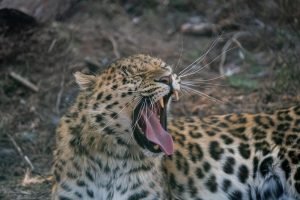Snow leopard and leopards are widely recognized. Because their fur has distinct hues, most people distinguish them. However, they are considerably different than you may imagine. So, here are a few key distinctions between them.

Fur
One of the most noticeable differences between snow leopards and leopards is their fur.
- Snow leopards have thick, fluffy fur that helps them to blend in with their snowy cold surroundings.
- Leopards, on the other hand, have shorter, smoother fur that is more camouflage-friendly in forests and other green environments.

Size
Another difference between these two species is their size.
- Snow leopards are larger than leopards, measuring anywhere from 6 to 7.5 feet in length and 77 to 120 pounds of weight. It has stocky body, long tail and powerful hind legs with large furry paws which facilitate movement across the snow.
- Leopards, on the other hand, are usually only 5 to 8.5 feet in length and 51 to 201 pounds of weight. It has large head, long body and relatively short legs.
Habitat
Perhaps the most significant difference between snow leopards and leopards is their habitat.
- Snow leopards live in the mountains of Central and South Asia, at altitudes above 10,000 feet. There are only 18 countries in the world where you can see them . Of the 18 countries, Mongolia’s Altai region (Khuiten peak) is the best place to see a wild snow leopard.
- Leopards, on the other hand, are found throughout Africa and Asia. In fact, they are the most widespread of all big cats. They can be found in forests, swamps, savannas, and even deserts .
Lifestyle and Diet
Another key difference between these two cats is their lifestyle and diet.
- Snow leopards are mostly solitary animals. They only come together to mate or raise cubs. Snow leopard is active at dusk and dawn. It often eats wild goats and sheep and occasionally hares, rodents and birds. Snow leopard can leap 30 to 50 feet to catch its prey.
- Leopards, on the other hand, are less shy and are often seen in pairs or small groups. Leopard is active during the night. It usually eats mid-sized antelopes, monkeys, reptiles, amphibians, birds and fish. Leopard often hides its prey in the trees.
Lifespan
- Leopard can survive 12 to 17 years in the wild and up to 24 years in the captivity.
- In captivity, a snow leopard can live up to 21 years. The precise duration of snow leopards in the wild is unknown.
Vocalization
Finally, snow leopards and leopards also vocalize differently.
- Snow leopards make a wide variety of sounds including hisses, mews, growls, wailing cries and grunts. Unlike other large cats, snow leopard cannot roar.
- Leopards purr like house cats when they are content but also make loud roars, grunts


